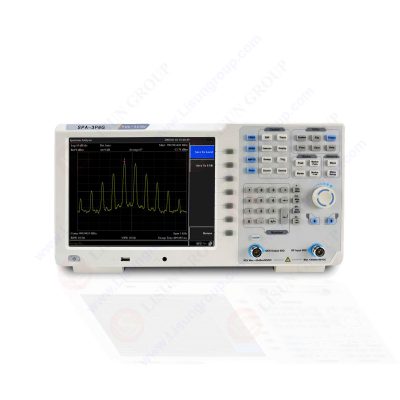
A spectrum analyzer is an instrument used to measure signal spectra, displaying frequency components and their relative amplitudes, aiding engineers and technicians in understanding signal characteristics.
In spectrum analysis, harmonics are crucial. Harmonics are integer multiples of the fundamental frequency signal, typically generated by nonlinear systems. In audio, radio frequency (RF), and power systems, the presence of harmonics can lead to issues like interference and efficiency loss. Understanding and managing these harmonics are vital to ensuring the proper operation of systems.
SPA-3P6G_Spectrum Analzer
Usage Guide: Measuring and Analyzing Harmonics
• Understanding Harmonics Basics:
Harmonics are signals with frequencies that are integer multiples of the fundamental frequency. While pure signals ideally lack harmonics, real-world systems with nonlinear components generate them.
• Selecting the Right Spectrum Analyzer:
Choose a spectrum analyzer that covers the frequency range of the signal of interest and its harmonics.
• Preparing the Spectrum Analyzer:
Preheat the spectrum analyzer for stability and accuracy. Check calibration status and calibrate if necessary.
• Setting Spectrum Analyzer Parameters:
Set parameters like center frequency, frequency span, resolution bandwidth (RBW), video bandwidth (VBW), and scan time based on signal characteristics.
• Connecting the Signal Source:
Use appropriate cables to connect the signal source to the spectrum analyzer’s input port. If using antennas, ensure correct installation and orientation.
• Initial Scan:
Perform an initial spectrum scan to observe signal distribution across the frequency range and identify the fundamental frequency and harmonic ranges.
• Precisely Locate Fundamentals and Harmonics:
Adjust center frequency and frequency span to center the fundamental frequency on the display. Use narrower resolution bandwidth for accurate frequency measurements.
• Measure Harmonic Amplitudes and Frequencies:
Utilize the spectrum analyzer’s marker function to measure harmonic amplitudes and frequencies, ensuring amplitude calibration accuracy.
• Analyze Harmonic Spectrum Characteristics:
Analyze harmonic frequency, amplitude, bandwidth, and modulation type to identify harmonic sources and generation mechanisms.
• Using Tracking Generators:
If the spectrum analyzer has a tracking generator, generate signals at the same frequencies for further analysis and harmonic source localization.
• Time Domain Analysis:
Some spectrum analyzers offer time-domain analysis to observe transient characteristics of harmonic signals.
• Advanced Spectrum Analyzer Features:
Utilize features like max hold, min hold, and averaging modes to reduce random noise effects for clearer harmonic observation.
• Harmonic Source Localization:
Based on measurement results, attempt to localize harmonic sources. Move the spectrum analyzer or use directional antennas if necessary.
• Harmonic Suppression Measures:
Upon identifying harmonic sources, implement corresponding suppression measures such as filtering, cable rearrangement, device setting adjustments, or using harmonic filters.
• Documentation:
Record measurement processes and results, including harmonic frequencies, amplitudes, possible harmonic sources, and suppression measures taken.
• Continuous Monitoring:
After addressing harmonic issues, regularly monitor using the spectrum analyzer to ensure harmonics do not reoccur.
• Maintenance of Spectrum Analyzer:
Regularly maintain and calibrate the spectrum analyzer to preserve its performance and accuracy.
• Advanced Analysis:
For complex harmonic issues, conduct advanced analyses such as total harmonic distortion (THD) analysis, power spectral density analysis, or modulation spectrum analysis.
Precautions:
• Ensure input signal levels do not overload to avoid measurement errors.
• Consider the modulation characteristics of signals, as modulation may affect harmonic measurements and analysis.
• Use specific measurement accessories (such as harmonic mixers or harmonic filters) for particular harmonic measurement tasks.
• Be mindful of DC components in signals, as they may affect measurement results.
• Consider environmental factors (such as temperature, humidity, and electromagnetic interference) that may influence measurement results.
• By following these steps and precautions, the spectrum analyzer can be a powerful tool for measuring and analyzing harmonics, assisting engineers in enhancing system performance and reliability.
https://www.lisungroup.com/news/technology-news/guide-to-using-a-spectrum-analyzer-for-harmonic-measurement.html


Comments
Post a Comment